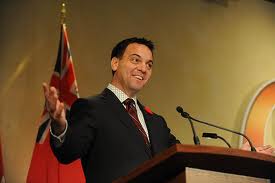Thursday’s five by-elections in Ontario were another blow to Ontario Progressive Conservative Leader Tim Hudak. This constitutes a real crisis of confidence.
The results need to be analyzed based on the expectations created by the polls and the media’s belief that ex-premier Dalton McGuinty had fatally undermined the Liberal party. On that basis, it was perfectly reasonable to expect the Liberals to lose every one of their seats, maybe just squeaking by in Scarborough-Guildwood; the Tories to win three or four of the five; and the NDP to win only Windsor-Tecumseh. From that perspective, a single Liberal win would have been a real godsend, allowing them to boast they were still contenders. That’s in fact what the Liberals expected and how they were prepared to spin it publicly. But that didn’t happen.
The Tory and NDP responses would have been equally predictable. Given the Conservative shut-out in Toronto for so many years, any victory would unleash delirium, while winning both Toronto seats, which they expected, would have been heaven. With three, or, as they quietly believed, four wins — everything but Windsor — they’d have been celebrating their unstoppable ascent to government. And they would have been right. But none of that happened.
Similarly, the NDP would have crowed about an easy Windsor win — an amazing 61 per cent in a former Liberal stronghold — but one victory was rightly not considered enough. They needed London West as well, although polls showed them running behind the Hudak candidate. Had they won only one of five, and had star candidate Adam Giambrone received only 21 per cent in Scarborough-Guildwood, as polls forecast, Thursday would have been a bad day in NDP circles. That Giambrone had won the nomination in dubious circumstances with unseemly backing by the party brass would have meant much salt in raw wounds. But none of that happened either.
Given this background, the results actually meant that Tim Hudak personally suffered yet another major defeat, after the 2011 election plus six by-election defeats in the past two years. Premier Kathleen Wynne was a surprise winner, with two seats where there could have been none; and the NDP did exactly what it needed to, with sudden new strength in western Ontario, having won a Kitchener-Waterloo by-election last year from the Conservatives, new seats in Windsor and London from the Liberals, and a surprisingly strong run by Giambrone in Scarborough-Guildwood.
What happens now? Conservative wheelers and dealers know what a liability Tim Hudak has become. In a nice bit of symmetry, he’s his party’s albatross just as ex-premier McGuinty has been the Liberals’. Hudak threw himself into these by-elections, yet the only one he won, in Etobicoke–Lakeshore, was a close thing, and he owes the victory to the candidate and the Ford brothers’ local machine. And that machine showed its severe limits, failing to deliver Scarborough-Guildwood to the Conservatives. (Mayor Rob Ford’s typically vicious attacks on Premier Wynne will no doubt help the City of Toronto to no end in its many dealings with Queen’s Park.)
The PC leader is an awful campaigner, sour, excessive, pushing people away with his very harshness. He’s utterly failed to enhance his public presence since he so badly blew the 2011 election. He’s also pushing perhaps the most reactionary, flagrantly class-based policies Ontarians have ever seen, making Mike Harris look like a bleeding-heart liberal.
Both his opponents are far more appealing public figures. Wynne is a real natural, a politician who seems not to spin, not to memorize speaking notes, not to pretend that her side is always right and her “enemies” always wrong. Her challenge of course is to jettison what remains of the McGuinty poisoned chalice. Thursday’s results suggest this is eminently possible, but she needs time to do so.
The NDP, too, remains very much in the game. The two by-election wins buttress the party’s already solid position in the province. Recent polling shows it at between 25 and 29 per cent province-wide, significantly higher than its 2011 vote. Even better, it’s the second choice of more voters than the other two parties, while NDP Leader Andrea Horwath continues to be competitive in the “best premier” category and commands very high personal ratings.
But Horwath faces the usual perplexing NDP conundrum when the Progressive Conservatives put on their ultra-conservative face — the incentive for liberal voters to vote Liberal to keep the Tories out. And with Wynne, that incentive may be hard to resist. It’s by no means impossible for the NDP to turn the tables so that it becomes the party for progressive Ontario, as happened way back in 1990, but it will take a credible platform and a shrewd strategy. That means the NDP too should be in no rush to force an election.
As Thursday showed, for both the Liberals and the NDP, Ontario is now up for grabs. May the best woman win.
This article was originally published in The Globe and Mail.



